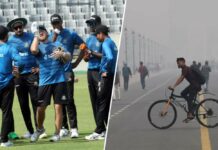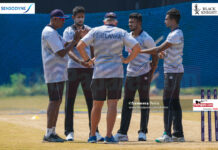South African cricketers celebrate the wicket of Kusal Perera (R) at the Sydney Cricket Ground during the 2015 Cricket World Cup quarter-final match between Sri Lanka and South Africa in Sydney on March 18, 2015.
Sri Lanka crashing out of the World Cup at the quarter-final stage was a bitter pill to swallow, but given the happenings lead up to the event it wasn’t unexpected. This is the first time after two consecutive World Cup finals, Sri Lanka will not feature in a World Cup final. This is also Sri Lanka’s worst World Cup campaign since 1999.
In the 14 nation competition, Sri Lanka beat Afghanistan, Bangladesh, England and Scotland and lost to New Zealand, Australia and South Africa. In reality, Sri Lanka failed to beat any team that was ranked above them.
What was painful during Sri Lanka’s quarter-final defeat was the manner in which the batting collapsed. Exceptional players of spin bowling not only failed to read two ordinary spin bowlers, but gifted a hat-trick to one of them. J.P. Duminy must be the worst bowler to take a hat-trick in ODIs. Many expected South Africa to choke, but the vice versa happened.
It was Sri Lanka’s bowling that was struggling and batting had looked impregnable and even scores in the range of 340 looked achievable given the form Kumar Sangakkara, Tillekeratne Dilshan and Lahiru Thirimanne were in.
The bowling and fielding were the worry. Sri Lanka’s openers fell to exceptional catches by the Proteas. That put them under pressure and the former champions never recovered. Catches indeed win matches.
Throughout the competition, Sri Lanka had gone with seven batsmen. For the quarter-final, they felt comfortable with just six batsmen given the fact that the batters were in form. But they weren’t ready just in case there was a collapse against world’s leading pace bowling attack.
The day before the game they had decided to go with seven batters and to leave out Thisara Perera. On the morning of the game, captain Angelo Mathews argued Perera’s case. He was drafted in the side and eventually Sri Lanka regretted not playing Upul Tharanga.
“Upul was another opener, who has 14 international hundreds. I think you make the best choices that you think for that particular occasion, and sometimes they go wrong. When we had that 11 walking out, I think everyone was pretty confident that we were good enough to do the job. But Kusal opening, yeah, maybe Thirimanne could have stuck on, maybe Upul could have come in, but like I said, hindsight is 20/20.”
Thisara Perera was the biggest let down in the tournament. There was so much expected of him but he achieved so little with both bat and ball with just one eye catching performance against Afghanistan. When he started, Thisara was kind of a player who could have done what Lance Klusener did for South Africa. However, with the way he is going, he could end up like Suresh Perera. Immensely talented, yet never materialised his full potential. Thisara was lousy on the field, erratic with the ball and inconsistent with the bat. In the World Cup, he wasn’t the only Sri Lankan fast bowler who was overweight.
Sri Lanka’s cause wasn’t helped by the list of injuries. Altogether five players from the original squad had to be replaced. Some of those replacements, honestly, weren’t bad. There were players who didn’t deserve to be in the World Cup squad and there were players who hadn’t featured in an ODI for more than a year before being named in the 15.
Undoubtedly, Sri Lanka picked the wrong squad for the World Cup. There are jokes in social media that rugby wasn’t the only sport that suffered interference from a powerful politician’s son.
Fielding was a discipline that was neglected by the national cricket team and finally when they realized that fielding woes need to be addressed, they were running short of time. Throughout the competition, Sri Lanka dropped 12 catches. While other teams took pride in diving and sliding to save boundaries, the Sri Lankans were content in chasing leather all the way to the boundary.
After all, this isn’t a bad side. The same team had won the Asia Cup, beaten England both home and away and won several other ODI competitions. They were gearing up nicely to the World Cup when out of the blues a series against India was fitted in. The players showed their vehement opposition. An angry Kumar Sangakkara took to twitter. Angelo Mathews expressed his displeasure in a media conferece, but the pleas fell on deaf ears. Sri Lanka Cricket is an institution that’s desperate to earn quick bucks. Its guardians openly say that for them the sport is a business. Then, who cares about results.
Two years ago, when changes were made to playing conditions of limited overs cricket with new rules such as fielding restrictions and two new balls, they were heavily favouring teams with good fast bowling units. Hence, it’s no secret that teams like South Africa, Australia and New Zealand are doing well. It was also a bit of surprise that having fiercely pushed for these changes England crashed out so early in the competition.
What the new rules have done is to diminish the relevance of spin bowlers. Since the rule changes came in putting fielding restrictions, spin bowlers have gone for over six runs an over. The two new balls ensure that the ball swings around for a considerable period of time.
Sri Lanka failed to realise the need to adjust the composition of their side to adjust to new playing conditions. They could have refrained from preparing spinner friendly wickets at home with the World Cup in mind to encourage seam bowlers and have a large crop. We were more conscious on smooth sailing and winning bilateral series on turning tracks rather than looking at the bigger picture. And in the end, we paid a heavy price.
Jean Paul Duminy’s hat-trick is the biggest insult to Sri Lankan cricket.














